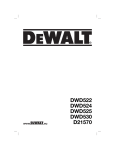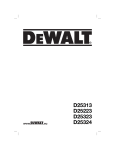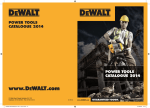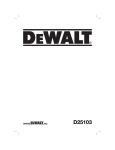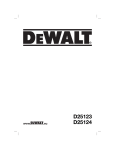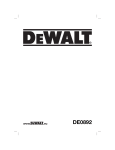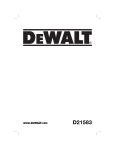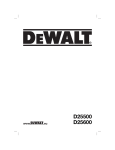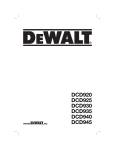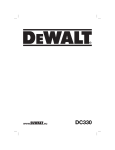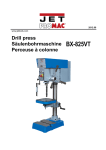Download DeWalt D21570 Technical data
Transcript
www. .eu DWD522 DWD524 DWD525 DWD530 D21570 Figure 1 DWD522/DWD524/DWD530 c DWD525 c d d g g b b e a a e j j i c d g h b a e D21570 j Figure 3 Figure 2 l b k a m e j 1 Figure 4 Figure 5 n DWD530/D21570 f d Figure 6 g e 2 Figure 7 c Figure 8 Figure 9 3 E NG L I S H DUAL SPEED PERCUSSION DRILL DWD522, DWD524, DWD525, DWD530, D21570 Congratulations! You have chosen a DEWALT tool. Years of experience, thorough product development and innovation make DEWALT one of the most reliable partners for professional power tool users. Technical Data Voltage UK & Ireland Type Power input No load speed Collar diameter Maximum chuck capacity Bits metal drilling low speed wood, flat boring bits, masonry drilling optimum maximum diamond core Weight LPA KPA LWA KWA (sound pressure) (sound pressure uncertainty) (sound power) (sound power uncertainty) mm mm DWD522 230 – 1 950 0–1250 / 0–3500 43 13 DWD524 230 230/115 1 1100 0–1250 / 0–3500 43 13 DWD525 230 230/115 1 1100 0–1250 / 0–3500 43 13 DWD530 230 230/115 1 1300 0–1250 / 0–3500 43 13 D21570 230 230/115 1 1300 0–1250 / 0–3500 43 16 mm mm 13 40 13 40 13 40 16 40 16 40 mm mm mm kg 5–10 20 – 2.8 5–10 22 – 2.8 5–10 22 – 2.8 5–10 22 – 2.8 5–10 22 127 3.0 dB(A) dB(A) dB(A) dB(A) 95 3 106 3 95 3 106 3 94 3 105 3 93 3 104 3 93 3 104 3 VAC VAC W min-1 Vibration total values (triax vector sum) determined according to EN 60745: Vibration emission value ah Drilling into metal ah,D = Uncertainty K = m/s² m/s² 5.5 4.3 5.5 4.3 4 1.5 7 4.8 – – Vibration emission value ah Impact drilling into concrete ah,ID = Uncertainty K = m/s² m/s² 18 6.3 18 6.3 15 1.9 16 4.6 16 4.6 Vibration emission value ah Drilling into concrete ah,DD = Uncertainty K = m/s² m/s² – – – – – – – – 13 6.8 27 EN GLI S H The vibration emission level given in this information sheet has been measured in accordance with a standardised test given in EN 60745 and may be used to compare one tool with another. It may be used for a preliminary assessment of exposure. WARNING: The declared vibration emission level represents the main applications of the tool. However if the tool is used for different applications, with different accessories or poorly maintained, the vibration emission may differ. This may significantly increase the exposure level over the total working period. An estimation of the level of exposure to vibration should also take into account the times when the tool is switched off or when it is running but not actually doing the job. This may significantly reduce the exposure level over the total working period. Identify additional safety measures to protect the operator from the effects of vibration such as: maintain the tool and the accessories, keep the hands warm, organisation of work patterns. Fuses Europe U.K. & Ireland 230 V tools 230 V tools 10 Amperes, mains 13 Amperes, in plugs Definitions: Safety Guidelines The definitions below describe the level of severity for each signal word. Please read the manual and pay attention to these symbols. DANGER: Indicates an imminently hazardous situation which, if not avoided, will result in death or serious injury. WARNING: Indicates a potentially hazardous situation which, if not avoided, could result in death or serious injury. CAUTION: Indicates a potentially hazardous situation which, if not avoided, may result in minor or moderate injury. NOTICE: Indicates a practice not related to personal injury which, if not avoided, may result in property damage. Denotes risk of electric shock. Denotes risk of fire. 28 EC-Declaration of Conformity MACHINERY DIRECTIVE DWD522, DWD524, DWD525, DWD530, D21570 DEWALT declares that these products described under “technical data” are in compliance with: 2006/42/EC, EN 60745-1, EN 60745-2-1. These products also comply with Directive 2004/108/EC. For more information, please contact DEWALT at the following address or refer to the back of the manual. The undersigned is responsible for compilation of the technical file and makes this declaration on behalf of DEWALT. Horst Grossmann Vice President Engineering and Product Development DEWALT, Richard-Klinger-Straße 11, D-65510, Idstein, Germany 26.06.2010 WARNING: To reduce the risk of injury, read the instruction manual. General Power Tool Safety Warnings WARNING! Read all safety warnings and all instructions. Failure to follow the warnings and instructions may result in electric shock, fire and/or serious injury. SAVE ALL WARNINGS AND INSTRUCTIONS FOR FUTURE REFERENCE The term “power tool” in the warnings refers to your mains-operated (corded) power tool or batteryoperated (cordless) power tool. 1) WORK AREA SAFETY a) Keep work area clean and well lit. Cluttered or dark areas invite accidents. b) Do not operate power tools in explosive atmospheres, such as in the presence of flammable liquids, gases or dust. Power tools create sparks which may ignite the dust or fumes. E NG L I S H c) Keep children and bystanders away while operating a power tool. Distractions can cause you to lose control. 2) ELECTRICAL SAFETY a) Power tool plugs must match the outlet. Never modify the plug in any way. Do not use any adapter plugs with earthed (grounded) power tools. Unmodified plugs and matching outlets will reduce risk of electric shock. b) Avoid body contact with earthed or grounded surfaces such as pipes, radiators, ranges and refrigerators. There is an increased risk of electric shock if your body is earthed or grounded. c) Do not expose power tools to rain or wet conditions. Water entering a power tool will increase the risk of electric shock. d) Do not abuse the cord. Never use the cord for carrying, pulling or unplugging the power tool. Keep cord away from heat, oil, sharp edges or moving parts. Damaged or entangled cords increase the risk of electric shock. e) When operating a power tool outdoors, use an extension cord suitable for outdoor use. Use of a cord suitable for outdoor use reduces the risk of electric shock. f) If operating a power tool in a damp location is unavoidable, use a residual current device (RCD) protected supply. Use of an RCD reduces the risk of electric shock. 3) PERSONAL SAFETY a) Stay alert, watch what you are doing and use common sense when operating a power tool. Do not use a power tool while you are tired or under the influence of drugs, alcohol or medication. A moment of inattention while operating power tools may result in serious personal injury. b) Use personal protective equipment. Always wear eye protection. Protective equipment such as dust mask, non-skid safety shoes, hard hat, or hearing protection used for appropriate conditions will reduce personal injuries. c) Prevent unintentional starting. Ensure the switch is in the off position before connecting to power source and/or battery pack, picking up or carrying the tool. Carrying power tools with your finger on the switch or energising power tools that have the switch on invites accidents. d) Remove any adjusting key or wrench before turning the power tool on. A wrench or a key left attached to a rotating e) f) g) part of the power tool may result in personal injury. Do not overreach. Keep proper footing and balance at all times. This enables better control of the power tool in unexpected situations. Dress properly. Do not wear loose clothing or jewellery. Keep your hair, clothing and gloves away from moving parts. Loose clothes, jewellery or long hair can be caught in moving parts. If devices are provided for the connection of dust extraction and collection facilities, ensure these are connected and properly used. Use of dust collection can reduce dust-related hazards. 4) POWER TOOL USE AND CARE a) Do not force the power tool. Use the correct power tool for your application. The correct power tool will do the job better and safer at the rate for which it was designed. b) Do not use the power tool if the switch does not turn it on and off. Any power tool that cannot be controlled with the switch is dangerous and must be repaired. c) Disconnect the plug from the power source and/or the battery pack from the power tool before making any adjustments, changing accessories, or storing power tools. Such preventive safety measures reduce the risk of starting the power tool accidentally. d) Store idle power tools out of the reach of children and do not allow persons unfamiliar with the power tool or these instructions to operate the power tool. Power tools are dangerous in the hands of untrained users. e) Maintain power tools. Check for misalignment or binding of moving parts, breakage of parts and any other condition that may affect the power tool’s operation. If damaged, have the power tool repaired before use. Many accidents are caused by poorly maintained power tools. f) Keep cutting tools sharp and clean. Properly maintained cutting tools with sharp cutting edges are less likely to bind and are easier to control. g) Use the power tool, accessories and tool bits etc., in accordance with these instructions taking into account the working conditions and the work to be performed. Use of the power tool for operations different from those intended could result in a hazardous situation. 29 EN GLI S H 5) SERVICE a) Have your power tool serviced by a qualified repair person using only identical replacement parts. This will ensure that the safety of the power tool is maintained. • Do not operate this tool for long periods of time. Vibration caused by hammer action may be harmful to your hands and arms. Use gloves to provide extra cushion and limit exposure by taking frequent rest periods. Additional Specific Safety Rules for Percussion Drills • Air vents often cover moving parts and should be avoided. Loose clothes, jewellery or long hair can be caught in moving parts. • Wear ear protectors when impact drilling. Exposure to noise can cause hearing loss. Residual Risks • Use auxiliary handle(s), if supplied with the tool. Loss of control can cause personal injury. The following risks are inherent to the use of drills: • Hold power tool by insulated gripping surfaces, when performing an operation where the cutting accessory may contact hidden wiring or its own cord. Cutting accessory contacting a “live” wire will make exposed metal parts of the power tool “live” and could give the operator an electric shock. • Use clamps or another practical way to secure and support the workpiece to a stable platform. Holding the work by hand or against your body leaves it unstable and may lead to loss of control. • Wear ear protectors when hammering for extended periods of time. Prolonged exposure to high intensity noise can cause hearing loss. Temporary hearing loss or serious ear drum damage may result from high sound levels generated by hammerdrilling. – Injuries caused by touching the rotating parts or hot parts of the tool. In spite of the application of the relevant safety regulations and the implementation of safety devices, certain residual risks cannot be avoided. These are: – Impairment of hearing. – Risk of squeezing fingers when changing accessories. – Health hazards caused by breathing dust developed when working in wood. – Risk of personal injury due to flying particles. – Risk of personal injury due to prolonged use. Markings on Tool The following pictograms are shown on the tool: Read instruction manual before use. • Wear safety goggles or other eye protection. Hammering and drilling operations cause chips to fly. Flying particles can cause permanent eye damage. Wear a dust mask or respirator for applications that generate dust. Ear protection may be required for most applications. • Always use the side handle supplied with the tool. Tighten the side handle securely before use. Keep a firm grip on the tool at all times. Do not attempt to operate this tool without holding it with both hands. Operating this tool with one hand will result in loss of control. Breaking through or encountering hard materials such as re-bar may be hazardous as well. • Always check core bits before usage. Never use damaged core bits. • Hammer bits and tools get hot during operation. Wear gloves when touching them. • Wear non-slip footwear to prevent injuries when standing or walking on slippery surfaces. • Only use cutting tools designed for this tool. Use of non-recommended cutting tools may lead to injuries due to loss of control. 30 Wear ear protection. Wear eye protection. DATE CODE POSITION (FIG. 1) The Date Code (h), which also includes the year of manufacture, is printed into the housing. Example: 2010 XX XX Year of Manufacture Package Contents The package contains: 1 Percussion drill 1 Side handle 1 Depth rod 1 Chuck key (D21570K only) E NG L I S H 1 Instruction manual 1 Exploded drawing • Check for damage to the tool, parts or accessories which may have occurred during transport. • Take the time to thoroughly read and understand this manual prior to operation. Description (fig. 1, 4) WARNING: Never modify the power tool or any part of it. Damage or personal injury could result. a. Trigger switch b. Reversing lever c. Chuck d. Speed/mode selector collar e. Side handle f. Indicator light (DWD530, D21570) g. Main handle h. Date code i. Chuck key (D21570) j. Lock-on button To stop the tool in continuous operation, press the switch briefly and release it. Always turn the tool off when work is finished and before unplugging. NOTE: Use lower speeds for starting holes, drilling in plastics or ceramics or for driving screws. REVERSING LEVER (FIG. 3) The reversing lever (b), located above the trigger switch, changes the direction of rotation of the percussion drill and is used when backing out screws and jammed drill bits. To operate the tool in reverse, release the trigger switch (a) and push the lever to the left (when viewed from the chuck end). To operate the drill in forward, release the trigger switch and push the lever to the right (when viewed from the chuck end). Return the reversing lever to the forward position after all operations in reverse are completed. HIGH/LOW SPEED OPERATION (FIG. 1, 5) The two speed gear drive in the dual range percussion drill permits effective operation over an extended range of applications with greater selection of accessories. INTENDED USE For LOW SPEED operation, turn the collar (d) to the drill bit symbol for drilling position 1. Your heavy-duty percussion drill has been designed for professional drilling and hammerdrilling applications. For HIGH SPEED operation, turn the collar (d) to the drill bit symbol for drilling position 2. The D21570 has been designed for professional dry diamond drilling into masonry. DO NOT use under wet conditions or in presence of flammable liquids or gases. These heavy-duty percussion drills are professional power tools. DO NOT let children come into contact with the tool. Supervision is required when inexperienced operators use this tool. TRIGGER SWITCH (FIG. 3) To start percussion drill, depress the trigger switch (a). To stop percussion drill, release the trigger switch. VARIABLE SPEED (FIG. 3) Variable speed permits speed control. The further the trigger switch (a) is depressed, the higher the speed of the percussion drill. If necessary, press the lock-on button (j) for continuous operation and release the switch. The lock-on button works only in full speed, forward rotation. The gear train has been designed for shifting only when the unit is off. It may be necessary, however, to rotate the chuck slightly by hand to align the gears while turning the collar. NOTICE: DO NOT ATTEMPT TO CHANGE SPEEDS by turning the collar when the tool is running. Doing so will damage the gear train. HAMMER/DRILL SELECTOR (FIG. 1, 5) To switch the tool from the drilling mode to the hammering mode (or vice-versa) rotate the collar (d) to the applicable symbol as shown in figure 5. Turn the collar (d) to the drill bit symbol for drilling or to the hammer symbol for hammerdrilling, as shown in the figure. TORQUE LIMITING CLUTCH This tool is equipped with a torque limiting clutch that reduces the maximum torque reaction transmitted to the operator in case of jamming of a drill bit. This feature also prevents the gearing and electric motor from stalling. The torque limiting clutch has been factory-set and cannot be adjusted. 31 EN GLI S H E-CLUTCH ANTI-LOCK CONTROL™ (FIG. 4) DWD530, D21570 Your DEWALT drill may come with an electronic feature called E-CLUTCH Anti-Lock Control™. It is designed to help you control the drill during a stall and keep it from pulling out of your hands. This may be encountered when drilling in steel or using large bits in wood. As a stall situation presents itself, the motor cycles on and off for a set period of time. This reduces the reaction of the stall and allows you to keep the drill under control. Releasing the trigger resets the E-Clutch and the unit will operate in normal mode when the trigger is depressed again. The E-CLUTCH Anti-Lock Control™ also incorporates an overload protection feature designed to help prevent the unit from becoming too hot during high load applications. If the unit becomes excessively hot during operation this feature will cut the motor, The feature will continue to cut the motor if it is restarted and placed under a high load before it has cooled off. Figure 4 shows the instruction label (n) mounted on the housing. There are two alert modes. 1. Engaged Mode: When a stall situation presents itself, the light will come on and stay on as the motor cycles on and off for a set period of time before the E-CLUTCH Anti-Lock Control™ completely shuts the tool down. When the unit is running in normal mode, there will be no light. 2. Problem Mode: A series of continual flashes as the trigger is pulled indicates that the electronics are no longer functioning. The tool may still be able to function without the benefit of E-CLUTCH Anti-Lock Control™ but should be serviced as soon as possible. Electrical Safety The electric motor has been designed for one voltage only. Always check that the power supply corresponds to the voltage on the rating plate. Your DEWALT tool is double insulated in accordance with EN 60745; therefore no earth wire is required. WARNING: 115 V units have to be operated via a fail-safe isolating transformer with an earth screen between the primary and secondary winding. 32 This product is intended to be used with a safety transformer manufactured to BSEN61558 and BS4343. Never work without this transformer in place. If the supply cord is damaged, it must be replaced by a specially prepared cord available through the DEWALT service organisation. Mains Plug Replacement (U.K. & Ireland Only) If a new mains plug needs to be fitted: • Safely dispose of the old plug. • Connect the brown lead to the live terminal in the plug. • Connect the blue lead to the neutral terminal. WARNING: No connection is to be made to the earth terminal. Follow the fitting instructions supplied with good quality plugs. Recommended fuse: 13 A. Using an Extension Cable If an extension cable is required, use an approved 3–core extension cable suitable for the power input of this tool (see technical data).The minimum conductor size is 1.5 mm2; the maximum length is 30 m. When using a cable reel, always unwind the cable completely. ASSEMBLY AND ADJUSTMENTS WARNING: To reduce the risk of injury, turn unit off and disconnect machine from power source before installing and removing accessories, before adjusting or changing setups or when making repairs. Be sure the trigger switch is in the OFF position. An accidental start-up can cause injury. Side Handle (fig. 2) WARNING: To reduce the risk of personal injury, ALWAYS operate the tool with the side handle properly installed. Failure to do so may result in the side handle slipping during tool operation and subsequent loss of control. Hold tool with both hands to maximize control. A side handle (e) is supplied with this percussion drill. It clamps to the front of the gear case as shown in figure 2 and can be rotated 360˚ for rightor left- hand use. E NG L I S H After the side handle is rotated into position, it should be pushed rearward until the slots (k) on the lip of the side handle are aligned with and fully engaged with the projecting tabs (m) on the underside of the gear case. The side handle is then securely clamped by turning clockwise until tight. OPERATION Instructions for Use WARNING: To reduce the risk of serious personal injury, turn tool off and disconnect tool from power source before making any adjustments or removing/installing attachments or accessories. WARNING: • Always observe the safety instructions and applicable regulations. • To reduce the risk of personal injury, ALWAYS ensure workpiece is anchored or clamped firmly. If drilling thin material, use a wood “back-up” block to prevent damage to the material. • To reduce the risk of personal injury, always operate the tool with the side handle properly installed. Failure to do so may result in the side handle slipping during tool operation and subsequent loss of control. Hold tool with both hands to maximize control. • Do not attempt to tighten or loosen drill bits (or any other accessory) by gripping the front part of the chuck and turning the tool on. Damage to the chuck and personal injury may occur. • Burn Hazard. ALWAYS wear gloves when changing bits. Accessible metal parts on the tool and bits may get extremely hot during operation. Small bits of broken material may damage bare hands. Proper Hand Position (fig. 6) WARNING: To reduce the risk of serious personal injury, ALWAYS use proper hand position as shown. WARNING: To reduce the risk of serious personal injury, ALWAYS hold securely in anticipation of a sudden reaction. Proper hand position requires one hand on the side handle (e) with the other hand on the main handle (g). Keyless Chuck (fig. 7–9) DWD522, DWD524, DWD525, DWD530 The DWD522, DWD524, DWD525 and DWD530 feature a keyless chuck (c) for greater convenience. To insert a drill bit or other accessory, follow the steps listed below. 1. Grasp the rear half of the chuck with one hand and use your other hand to rotate the front half counterclockwise, as shown in figure 7. Rotate far enough so that the chuck opens sufficiently to accept the desired accessory. 2. Insert the bit or other accessory about 3/4" (19 mm) into the chuck and tighten securely by holding the rear half of the chuck and rotating the front portion in the clockwise direction. When the chuck is nearly tightened, you will hear a clicking sound. After 4–6 clicks, the chuck is securely tightened around the accessory. 3. To release the accessory, repeat step 1 listed above. WARNING: Do not attempt to tighten drill bits (or any other accessory) by gripping the front part of the chuck and turning the tool on. Damage to the chuck and personal injury may result. KEYLESS CHUCK REMOVAL (FIG. 8) Tighten the chuck around the shorter end of a hex key (not supplied) of 1/4" (6 mm) or greater size. Using a soft hammer or piece of wood, strike the longer end in the counterclockwise direction. This will loosen the chuck so that it can be unscrewed by hand. KEYLESS CHUCK INSTALLATION (FIG. 9) Screw the chuck on by hand as far as it will go. Tighten the chuck around the shorter end of a 1/4" (6 mm) or larger hex key (not supplied). Strike the longer end in the clockwise direction with a soft hammer. Keyed Chuck (fig. 1) D21570 The D21570 features a keyed chuck (c). To insert a drill bit or other accessory, follow the steps listed below. 1. Tighten chuck collar by hand. 33 EN GLI S H 2. Place chuck key in each of the three holes, and tighten in clockwise direction. It’s important to tighten chuck with all three holes to prevent slippage. To release bit, turn chuck key counterclockwise in just one hole, then loosen the chuck by hand. Any authorized DEWALT service center can install a keyless chuck in place of a keyed chuck. Depth Rod (fig. 2) TO ADJUST THE DEPTH ROD (L): Loosen the handle (e) and move rod so that the distance between the end of the rod and the end of the bit equals the desired drilling depth. When drilling with depth rod, stop when end of rod reaches surface of material. Drilling Turn the collar to the drill bit symbol for drilling or to the hammer symbol for hammerdrilling. Install and tighten the desired drill bit in the chuck. DRILLING OPERATION Select the desired speed/torque range using the speed selector collar to match the speed and torque to the planned operation. 1. For WOOD, use twist bits, spade bits, power auger bits or hole saws. For METAL, use highspeed steel twist drill bits or hole saws. Use a cutting lubricant when drilling metals. The exceptions are cast iron and brass which should be drilled dry. For MASONRY, use carbidetipped bits or masonry bits. A smooth, even flow of dust indicates the proper drilling rate. 2. Always apply pressure in a straight line with the bit. Use enough pressure to keep the drill bit biting, but do not push hard enough to stall the motor or deflect the bit. 3. Hold tool firmly with both hands to control the twisting action of the drill. WARNING: Drill may stall if overloaded causing a sudden twist. Always expect the stall. Grip the drill firmly with both hands to control the twisting action and avoid injury. 4. IF DRILL STALLS, it is usually because it is being overloaded. RELEASE TRIGGER IMMEDIATELY, remove drill bit from work, and determine cause of stalling. DO NOT CLICK TRIGGER OFF AND ON IN AN ATTEMPT TO START A STALLED DRILL – THIS CAN DAMAGE THE DRILL. 34 5. To minimize stalling or breaking through the material, reduce pressure on drill and ease the bit through the last fractional part of the hole. 6. Keep the motor running when pulling the bit back out of a drilled hole. This will help prevent jamming. 7. With variable speed drills there is no need to center punch the point to be drilled. Use a slow speed to start the hole and accelerate by squeezing the trigger harder when the hole is deep enough to drill without the bit skipping out. HAMMERDRILL OPERATION 1. When drilling, use just enough force on the hammer to keep it from bouncing excessively or “rising” off the bit. Too much force will cause slower drilling speeds, overheating and a lower drilling rate. 2. Drill straight, keeping the bit at a right angle to the work. Do not exert side pressure on the bit when drilling as this will cause clogging of the bit flutes and a slower drilling speed. 3. When drilling deep holes, if the hammer speed starts to drop off, pull the bit partially out of the hole with the tool still running to help clear debris from the hole. 4. For masonry, use carbide-tipped bits or masonry bits. A smooth even flow of dust indicates the proper drilling rate. DIAMOND DRILLING D21570 The D21570 is designed for dry diamond drilling into masonry up to 127 mm. For diamond drilling above this diameter in masonry and regular large diameter diamond drilling in masonry and concrete, we advise the use of a DEWALT D21580, D21582 or D21583 diamond core drill. Use speed 2 for diamond core bits with diameters between 22–68 mm. Always use speed 1 for diamond core bits between 68 mm and 127 mm in diameter. Follow the core bit or manufacturer’s recommendations for using the accessory. NOTE: Always use core bits with integral centredrill systems. 1. Insert the centredrill into its holder in the centre of the core bit. Drill at low speed until the core penetrates the surface approximately 5–10 mm. E NG L I S H 2. Remove and unplug the machine. 3. Remove the centredrill from its holder. 4. Plug the machine in and insert the core bit into the workpiece. 5. Begin drilling, increasing to full speed and drill to the desired depth. MAINTENANCE Your DEWALT power tool has been designed to operate over a long period of time with a minimum of maintenance. Continuous satisfactory operation depends upon proper tool care and regular cleaning. WARNING: To reduce the risk of injury, turn unit off and disconnect machine from power source before installing and removing accessories, before adjusting or changing set-ups or when making repairs. Be sure the trigger switch is in the OFF position. An accidental start-up can cause injury. Lubrication Your tool was properly lubricated before leaving the factory. In from two to six months, depending upon use, take or send your tool to an authorised service centre for a complete cleaning, inspection and lubrication. Tools used constantly on production jobs will need relubrication more often. Also, tools “out of service” for long periods should be relubricated before being put back to work. Cleaning WARNING: Blow dirt and dust out of the main housing with dry air as often as dirt is seen collecting in and around the air vents. Wear approved eye protection and approved dust mask when performing this procedure. Optional Accessories WARNING: Since accessories, other than those offered by DEWALT, have not been tested with this product, use of such accessories with this tool could be hazardous. To reduce the risk of injury, only DEWALT recommended accessories should be used with this product. Consult your dealer for further information on the appropriate accessories. Protecting the Environment Separate collection. This product must not be disposed of with normal household waste. Should you find one day that your DEWALT product needs replacement, or if it is of no further use to you, do not dispose of it with household waste. Make this product available for separate collection. Separate collection of used products and packaging allows materials to be recycled and used again. Re-use of recycled materials helps prevent environmental pollution and reduces the demand for raw materials. Local regulations may provide for separate collection of electrical products from the household, at municipal waste sites or by the retailer when you purchase a new product. DEWALT provides a facility for the collection and recycling of DEWALT products once they have reached the end of their working life. To take advantage of this service please return your product to any authorised repair agent who will collect them on our behalf. You can check the location of your nearest authorised repair agent by contacting your local DEWALT office at the address indicated in this manual. Alternatively, a list of authorised DEWALT repair agents and full details of our after-sales service and contacts are available on the Internet at: www.2helpU.com. WARNING: Never use solvents or other harsh chemicals for cleaning the non-metallic parts of the tool. These chemicals may weaken the materials used in these parts. Use a cloth dampened only with water and mild soap. Never let any liquid get inside the tool; never immerse any part of the tool into a liquid. 35 EN GLI S H GUARANTEE DEWALT is confident of the quality of its products and offers an outstanding guarantee for professional users of the product. This guarantee statement is in addition to and in no way prejudices your contractual rights as a professional user or your statutory rights as a private non-professional user. The guarantee is valid within the territories of the Member States of the European Union and the European Free Trade Area. • 30 DAY NO RISK SATISFACTION GUARANTEE • If you are not completely satisfied with the performance of your DEWALT tool, simply return it within 30 days, complete with all original components, as purchased, to the point of purchase, for a full refund or exchange. The product must have been subject to fair wear and tear and proof of purchase must be produced. • ONE YEAR FREE SERVICE CONTRACT • If you need maintenance or service for your DEWALT tool, in the 12 months following purchase, you are entitled to one service free of charge. It will be undertaken free of charge at an authorised DEWALT repair agent. Proof of purchase must be produced. Includes labour. Excludes accessories and spare parts unless failed under warranty. • ONE YEAR FULL WARRANTY • If your DEWALT product becomes defective due to faulty materials or workmanship within 12 months from the date of purchase, DEWALT guarantees to replace all defective parts free of charge or – at our discretion – replace the unit free of charge provided that: • The product has not been misused; • The product has been subject to fair wear and tear; • Repairs have not been attempted by unauthorised persons; • Proof of purchase is produced; • The product is returned complete with all original components. If you wish to make a claim, contact your seller or check the location of your nearest authorised DEWALT repair agent in the DEWALT catalogue or contact your DEWALT office at the address indicated in this manual. A list of authorised DEWALT repair agents and full details of our after-sales service is available on the Internet at: www.2helpU.com. 36 Belgique et Luxembourg België en Luxemburg Black & Decker - DEWALT Nieuwlandlaan 7, IZ Aarschot B156 B-3200 Aarschot Danmark DEWALT Sluseholmen 2-4 2450 København SV Tlf: 70201511 Fax: 70224910 www.dewalt.dk Deutschland DEWALT Richard Klinger Str. 11 65510 Idstein Tel: 06126-21-1 Fax: 06126-21-2770 www.dewalt.de Ελλάς Black & Decker (Ελλάς) Α.Ε. Στράβωνος 7 & Βουλιαγμένης 159 Γλυφάδα 16674, Αθήνα España DEWALT Parque de Negocios “Mas Blau” Edificio Muntadas, c/Bergadá, 1, Of. A6 08820 El Prat de Llobregat (Barcelona) Tel: 934 797 400 Fax: 934 797 419 www.dewalt.es France DEWALT 5, allée des hêtres BP 30084, 69579 Limonest Cedex Tel: 04 72 20 39 20 Fax: 04 72 20 39 00 www.dewalt.fr Schweiz Suisse Svizzera DEWALT In der Luberzen 40 8902 Urdorf Tel: 01 - 730 67 47 Fax: 01 - 730 70 67 www.dewalt.ch Ireland DEWALT Calpe House Rock Hill Black Rock, Co. Dublin Tel: 00353-2781800 Fax: 00353-2781811 www.dewalt.ie Italia DEWALT Viale Elvezia 2 20052 Monza (Mi) Tel: 800-014353 Fax: 039-2387592 www.dewalt.it Nederlands Black & Decker - DEWALT Joulehof 12 4600 AB Bergen Op Zoom Tel: +31 164 283 063 Fax: +31 164 283 200 www.dewalt.nl Norge DEWALT Postboks 4613, Nydalen 0405 Oslo Tel: 45 25 13 00 Fax: 45 25 08 00 www.dewalt.no Österreich DEWALT Werkzeug Vertriebsges m.b.H Oberlaaerstrasse 248 A-1230 Wien Tel: 01 - 66116 - 0 Fax: 01 - 66116 - 14 www.dewalt.at Portugal DEWALT Centro de Escritórios de Sintra Avenida Almirante Gago Coutinho, 132/134, Edifício 142710-418 Sintra 2710-418 Lisboa Tel: 214 66 75 00 Fax: 214 66 75 75 www.dewalt.pt Suomi DEWALT Tekniikantie 12 02150 Espoo, Finland Puh: 010 400 430 Faksi: 0800 411 340 www.dewalt.fi Sverige DEWALT Box 94 431 22 Mölndal Tel: 031 68 61 00 Fax: 031 68 60 08 www.dewalt.se Türkiye KALE Hırdavat ve Makina A.Ş. Defterdar Mah. Savaklar Cad. No:15 Edirnekapı / Eyüp / İSTANBUL 34050 TÜRKİYE Tel: 0212 533 52 55 Faks: 0212 533 10 05 www.dewalt.com.tr United Kingdom DEWALT 210 Bath Road; Slough, Berks SL1 3YD Middle East Africa DEWALT P.O. Box - 17164, Jebel Ali (South Zone), Dubai, UAE N093407 Dutch Tel: +32 70 220 063 French Tel: +32 70 220 062 Fax: +32 70 225 585 Fax: +32 70 222 441 www.dewalt.be Τηλ: +30 210 8981-616 www.dewalt.gr Service: +30 210 8981-616 Φαξ: +30 210 8983-570 Tel: Fax: 01753-56 70 55 01753-57 21 12 www.dewalt.co.uk Tel: +971 4 8863030 Fax: +971 4 8863333 www.dewalt.ae 10/10















